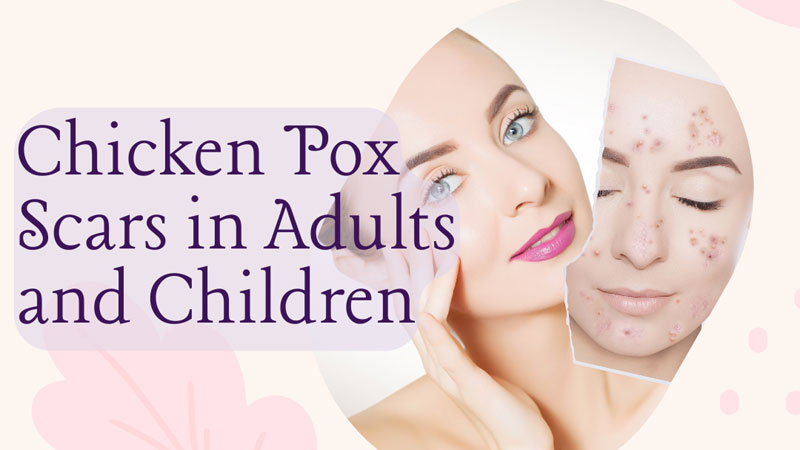Chickenpox is a highly contagious disease caused by the varicella-zoster virus. Once infected, one has to endure 5-10 days of fever, headaches, and an itchy rash. Chickenpox is, unfortunately, a rite of passage all children must endure. But even though the disease is often not deadly, it can leave scars on your body and face. This can be disheartening and uncomfortable for those who have the scars.

While vaccination has brought down the incidents of chickenpox to a large extent, chickenpox scars are one of the more common skin conditions in children. It can also affect grown-ups and adults who never had chickenpox before and thus didn’t build immunity against it.
One of chickenpox’s most common side effects is a rash of small, itchy red spots. As the blisters crack open and crust over, they can become extremely itchy. It is entirely natural to scratch these spots, but excessive scratching can damage them.
Chicken pox scars are a form of atrophic scarring. Atrophic means losing tissue; thus, scarring is seen as a loss of skin volume. These scars can be fully or partially healed, fresh or fading. The classic chicken pox lesion has an off-center umbilication (a red, swollen, inflamed center with pitting and crusting) and a whitish center surrounded by a raised red edge. Chickenpox leaves survivors with subtle scarring, which can develop into a more profound scar years after infection.
The good news is that there are several home remedies for removing chicken pox scars. You can try them at home to see if they work for you.
List of 5 Home Remedies For Removing Chicken Pox Scars
1. Aloe Vera Gel
Aloe vera gel helps reduce the appearance of scars and moisturizes your skin. Take some aloe vera gel and apply it on the marks regularly so that they fade away gradually. You can also use an aloe vera gel face mask to naturally accelerate the process of naturally fading your scars!
2. Vitamin E
Vitamin E can help to reduce the appearance of your scars. It has anti-inflammatory properties and can help speed up the healing process by getting rid of dead skin cells on the surface of your skin.
3. Coconut Water
Coconut water is an excellent natural remedy for scar removal. It contains lauric acid, which is an excellent moisturizer. The acid helps reduce the redness of scars and prevents skin dryness. Coconut water also has antibacterial properties that help to prevent infections in scars.
4. Lemon Juice
The vitamin C in lemon juice helps heal the skin by promoting collagen production and speeding up the healing process. Lemon juice also contains antioxidants that help reduce the appearance of scarring and discoloration by fighting free radicals in the body.
5. Rosehip Oil
Rosehip oil is the perfect natural remedy for scars. Rosehip oil contains vitamin C, which helps speed healing and reduce inflammation. If you have a scar that has already formed, then rosehip seed oil can be used to help reduce its appearance and make it less noticeable.
Top Over-The-Counter Treatments For Scars
Topical treatments are creams, ointments, and gels that you apply directly to your skin. They include:
1. Retinoids
These include tretinoin (Retin-A), adapalene (Differin) and tazarotene (Tazorac). Retinoids are topical versions of vitamin A, which helps increase collagen production in the skin. You can buy these products over the counter, but they may cause redness, itching, or peeling as side effects.
2. Exfoliants
Exfoliating is a great way to accelerate the fading of scars. Exfoliation removes the top layer of skin and allows new skin to grow in its place. This process also helps remove excess melanin (skin pigment), making the scar appear darker.
3. Topical Cream
Over-the-counter topical creams containing alpha hydroxy acids (AHAs) are most commonly used to treat chickenpox scars. These include glycolic acid, lactic acid, or mandelic acid. AHAs work by removing the top layer of skin cells and stimulating new cell growth, which helps to soften and fade the scar.
4. Sunscreen
Applying sunscreen, as the dermatologist recommends, is a great way to prevent scarring, but it’s essential to use it correctly. Sunscreen with an SPF of 30 or higher should be applied every two hours, even in the shade.
Sunscreen should also be applied immediately after you’ve been in the sun and washed your face.
5. Silicone Sheets
The best over-the-counter treatments for chicken pox scars are silicone sheets. These thin, flexible sheets made from silicone gel infused with vitamin E, aloe vera, and other natural ingredients go on top of the scar and gently stretch out over a few months. The silicone sheet helps to flatten and smooth the scar, causing it to fade more quickly than usual.
Professional Methods of Treatments For Chickenpox Scars
1. Laser Resurfacing
Laser resurfacing is one of the dermatologists’ most trusted methods to treat chickenpox scars at leading clinics. This treatment uses intense light pulses to remove damaged skin and stimulate new collagen production. The laser beam penetrates deep into the dermis layer of your skin, stimulating collagen growth below the surface. This reduces the appearance of your chickenpox scarring over time by smoothing out its texture and reducing redness.
Dermatologists ensure that the intensity of the laser device is carefully controlled to avoid damaging the surrounding healthy skin tissue. This ensures minimal side effects from this procedure, such as temporary swelling, redness, or tenderness around your scarring area after treatment.
2. Chemical Peeling Treatment
Chemical peeling is an effective treatment for reducing the appearance of scars. Chemical peeling involves applying a chemical solution to your skin that causes the outer layer of the skin to peel off, revealing new skin underneath. This process can be repeated several times until you achieve your desired results. The most common types of chemical peels include glycolic acid and salicylic acid.
3. Subcision Surgery
Subcision is a minimally invasive, nonsurgical treatment recommended by dermatologists for depressed or sunken scars. Subcision involves injecting a small amount of local anesthetic into the scar tissue. This loosens the scar, which allows for the removal of excess skin and the elevation of depressed areas.
Subcision is performed under local anesthesia and can be repeated as many times as necessary over several months to achieve optimum results.
4. Microneedling Radiofrequency
Microneedling Radiofrequency is a combination of micro-needling and radiofrequency. This treatment is one of the most effective methods for chickenpox scar removal. It uses needles to create tiny channels in the skin that allow for deeper penetration of the active ingredients, thus increasing their effectiveness. This new technology also causes less damage to healthy skin tissue than regular laser resurfacing methods.
5. Surgical Procedures
If you are looking for an aggressive and quicker solution, several surgical procedures can help improve the appearance of chickenpox scars. These include:
- Grafting: Grafting is a technique used to cover up scars with healthy skin. Small areas can be covered by removing a square piece of healthy skin from another part of the body (donor site) and then placing this new skin over the scar.
- Dermabrasion: Dermabrasion is a procedure that removes damaged skin on the surface layer of your skin while also smoothing out any wrinkles or irregularities. Dermabrasion can also remove small scars left behind by chickenpox, but larger ones may need other methods for improvement
- Microdermabrasion This procedure uses a diamond tip to sand down the skin’s surface gently, removing scar tissue and discoloration.
How To Prevent Chickenpox Scars
Preventive Measures That You Can Take To Avoid The Formation of Scars
- Avoid scratching your skin during a chickenpox outbreak, which can lead to scarring.
- Wear loose-fitting clothes that don’t irritate your skin if you have chickenpox (for example, short sleeves)
- Cleanse the affected area daily with warm water and soap or an antibacterial cleanser until all scabs have been removed. Use moisturizing lotion on any dry patches that might develop afterward.
- Apply petroleum jelly or aloe vera gel to help soothe any itching or irritation caused by smaller scabs leaving behind tiny marks on your skin when they fall off.
Consulting A Doctor For Chicken Pox Scars In India
The first step to treating chickenpox scars is consulting your doctor, who will prescribe you medications that will help reduce inflammation caused by chickenpox and help heal any open sores caused due to this infection. A doctor may also suggest some home remedies, like applying aloe vera gel on affected areas, which helps reduce inflammation caused by chickenpox.
Cost of Chickenpox Scar Removal in India?
The cost of chicken pox scar removal in India depends on several factors, such as where you live and which clinic you choose to go with. Location, type of treatment required, duration of the procedure, and experience of the doctor performing treatment.
The cost of removing chicken pox scars can vary from Rs 40,000 to Rs 1 lakh depending on the type of treatment required for each patient.
The Takeaway
Chicken pox scars are emotional, physical, and visual reminders of our suffering to be healthy. While they are not the end of the world, some people will be disheartened at the notion that they have to live with these marks for the rest of their lives.
The good news is that there are methods to reduce (or even eliminate) chickenpox scars! A combination of treatments may help to lighten or remove your chickenpox scars.
Birthmarks and deep scars may require more invasive treatments, such as surgical procedures that improve the appearance of your skin. If you want to know how to get rid of chickenpox scars in India, you can consult our experts at Kolors Healthcare. They will assess your condition and tell you how they can help you achieve your desired results. For more details or to book an appointment, log onto www.kolorshealthcare.com.
Chicken Pox Scars in Adults and Children FAQs
1. Which Cream is Best For Chickenpox Scars?
- Retinoids:: These include tretinoin (Retin-A), adapalene (Differin), and tazarotene (Tazorac). Retinoids are topical versions of vitamin A, which helps increase collagen production in the skin. You can buy these products over the counter, but they may cause redness, itching, or peeling as side effects.
- Exfoliants:: Exfoliating is a great way to accelerate the fading of scars. Exfoliation removes the top layer of skin and allows new skin to grow in its place. This process also helps remove excess melanin (skin pigment), making the scar appear darker.
- Topical Cream:: Over-the-counter topical creams containing alpha hydroxy acids (AHAs) are most commonly used to treat chickenpox scars. These include glycolic acid, lactic acid or mandelic acid. AHAs work by removing the top layer of skin cells and stimulating new cell growth, which helps to soften and fade the scar. Some of India’s chicken pox removal creams are Senvie Selevax and Lakshmi krishna naturals Chicken Pox Scar Removal Kit. It is always best to consult a doctor before using these or contact Kolors for an expert approach.
- Sunscreen:: Applying sunscreen as the dermatologist recommends is a great way to prevent scarring, but it’s important to use it correctly. Sunscreen with an SPF of 30 or higher should be applied every two hours, even in the shade. Sunscreen should also be applied immediately after you’ve been in the sun and washed your face.
2. How Long Does It Take For A Chicken Pox Scar To Go Away?
In most cases, chicken pox scars go away on their own. However, some people will have scars that last for a long time. This can be due to the severity of chicken pox or the location and size of the scar.
Scars from chicken pox can completely fade away from a few months to several years.
3. How To Prevent Chickenpox Scarring?
- Avoid scratching your skin during a chickenpox outbreak because this can lead to scarring.
- Wear loose-fitting clothes that don’t irritate your skin if you have chickenpox (for example, short sleeves)
- Cleanse the affected area daily with warm water and soap or an antibacterial cleanser until all scabs have been removed. Use moisturizing lotion on any dry patches that might develop afterward.
- Apply petroleum jelly or aloe vera gel to help soothe any itching or irritation caused by smaller scabs leaving behind tiny marks on your skin when they fall off.










The chicken pox scars will fade over time as new skin replaces old skin and collagen rebuilds the matrix that was damaged during the illness. Ultimately, it may take up to six months for all traces of chicken pox to disappear. It is important to keep hydrated and avoid direct sunlight while recovering from this highly contagious disease. If it doesn’t go in 6 months, you can refer to the tips given in the above article.
I have read in one of the blogs that Aloe vera is effective in removal of the scars. Can aloe vera also remove chickenpox scars or lighten it up?
Aloe vera can regenerate damaged tissues to some extent. It is more used to reduce redness and inflammation though. It might not remove the scars altogether but might lighten it by a small percentage. Apply the gel on the scar from a fresh leaf. Once dry, wash it off with water. Check after a week if it helps.
i have been chicken pox scar last 3 years and it’s still don’t recover , what should I do
I have chickenpox scars on my face and it’s been there for years. I am an African girl. What home remedy can help fade my dark pigmented scars. Can applying coconut oil help. And if it does how long will it take to fade the scares. What topical cream can be recommended for me also